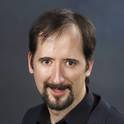
Symmetry-breaking phase transitions are an example of non-equilibrium processes that require real-time treatment, a major challenge in strongly coupled systems without long-lived quasiparticles. Holographic duality provides such an approach by mapping strongly coupled field theories in D dimensions into weakly coupled quantum gravity in Dþ1 anti-de Sitter spacetime. Here we use holographic duality to study the formation of topological defects—winding numbers—in the course of a superconducting transition in a strongly coupled theory in a 1D ring. When the system undergoes the transition on a given quench time, the condensate builds up with a delay that can be deduced using the Kibble–Zurek mechanism from the quench time and the universality class of the theory, as determined from the quasinormal mode spectrum of the dual model. Typical winding numbers deposited in the ring exhibit a universal fractional power law dependence on the quench time, also predicted by the Kibble–Zurek Mechanism.

Published in Nature Communications: https://dx.doi.org/10.1038/ncomms8406